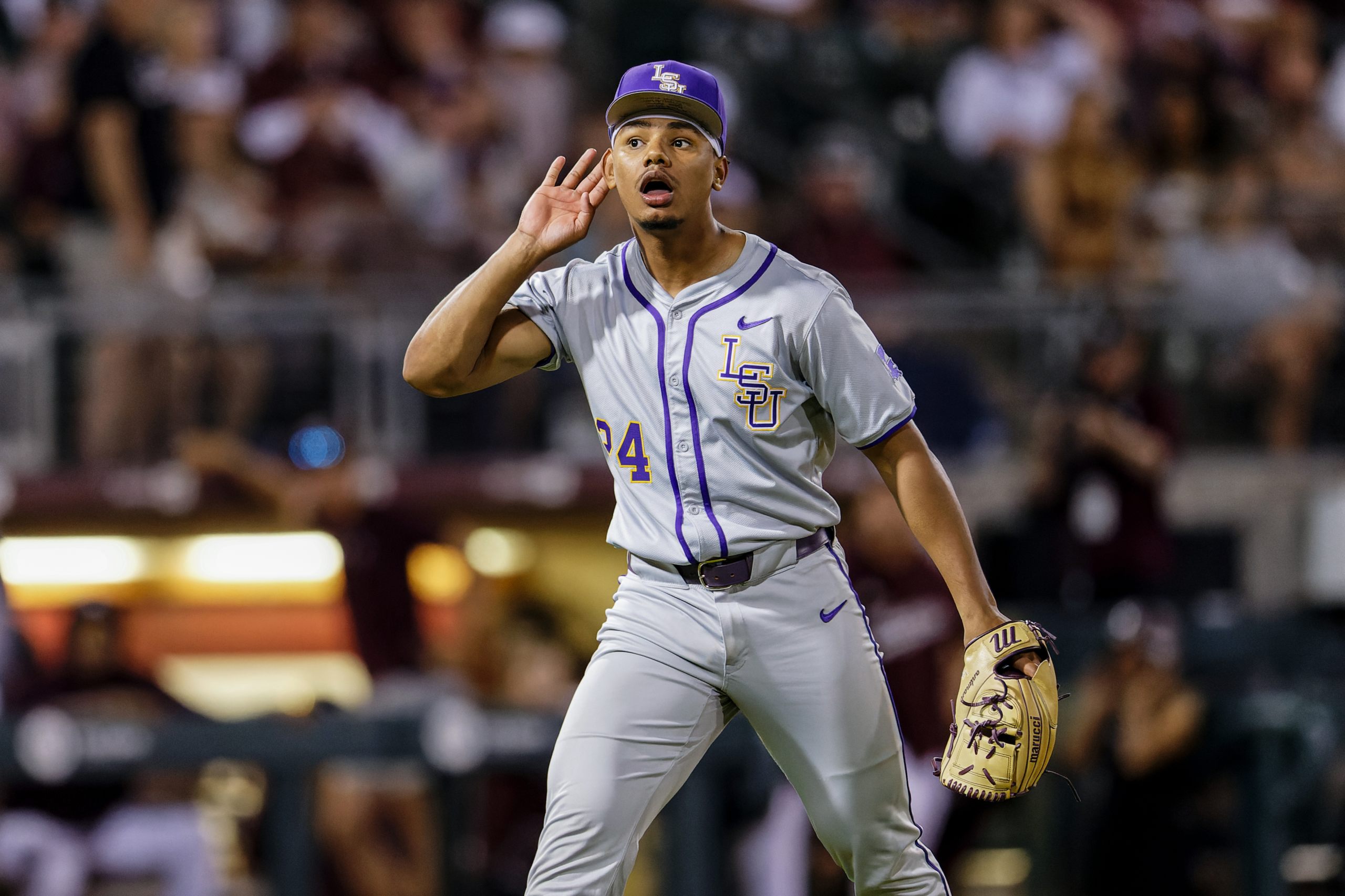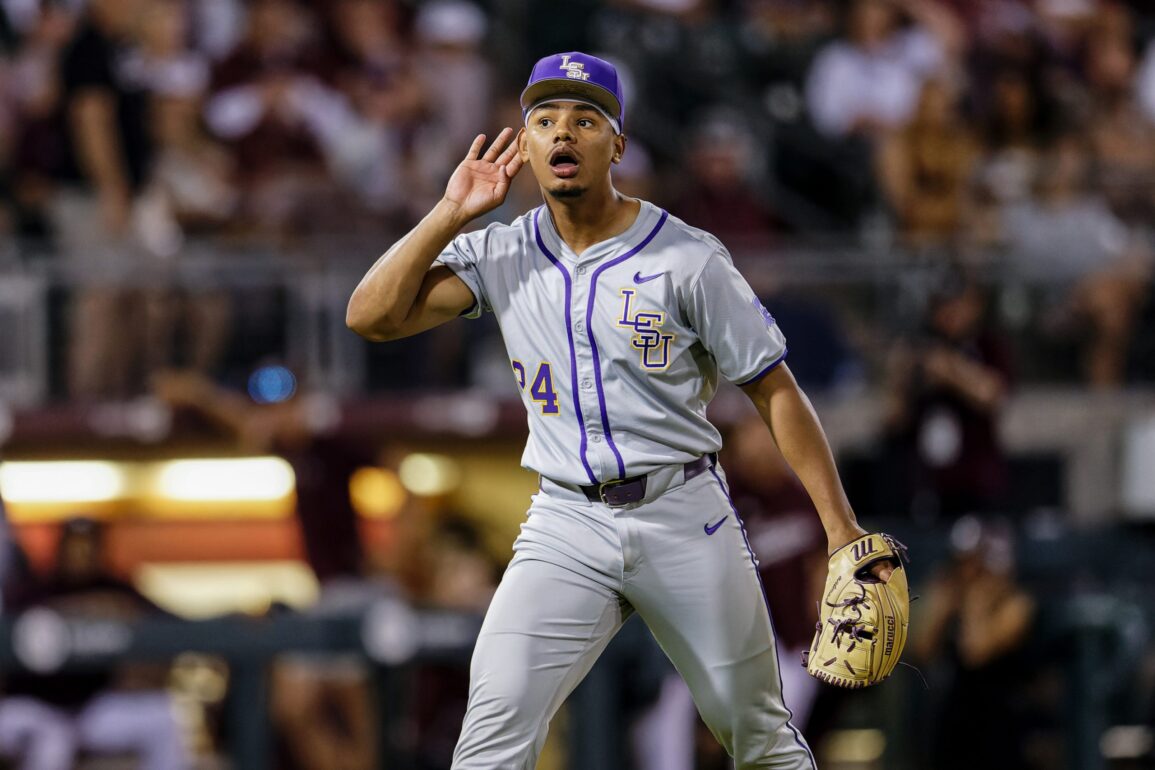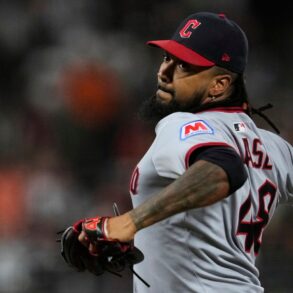
With the draft fast approaching, I thought it would be a fun exercise to examine a few college players who currently project outside of the first round for 2025 MLB Draft but could still be selected in that range on night one come July.
Below you will find a handful of players—listed alphabetically—who have a chance to be eventual first-round picks. All five currently rank outside the top 30 on the most recent Baseball America draft rankings for 2025.
Anthony Eyanson, RHP, LSU
A two-year standout at UC San Diego, Eyanson has blossomed during his time in Baton Rouge. He’s in the midst of a career year in which he’s compiled a 2.74 ERA with 142 strikeouts to 35 walks across 98.2 innings. Eyanson has always possessed advanced pitchability and has a simple, repeatable delivery, though his stuff has ticked up across the board. His average fastball velocity has increased from 91.5 to 93, and he’s thrown 120 pitches at 95+ this season compared to just four last year. It still doesn’t generate a ton of whiffs, though, and this spring it ran a modest 16% whiff rate.
The biggest revelation in Eyanson’s arsenal has been the progression of his slider. He’s increased its usage, and it’s routinely flashed plus with two-plane bite. It’s gotten sharper since last year, and it’s generated an impressive 52% whiff rate and 47% chase rate. Eyanson’s curveball remains a valuable weapon, and it’s distinct in shape from his slider. It flashes plenty of depth at times with sharp, downward tilt. This spring, it garnered a 38% whiff rate—up from 24% in 2024.
Boasting an appealing blend of strikes, stuff and a lengthy track record of performance, Eyanson could sneak his way into the back of the first round.
Mason Neville, OF, Oregon
Of the five players highlighted here, Neville is probably the biggest dark horse to be selected in the first round. He’s been a tool shed dating back to his days as a prepster, but this was the first season in which he put everything together. Neville posted a .290/.429/.724 slash line in 2025 with 16 doubles, a nation-leading 26 home runs and 57 RBIs. Perhaps most notably, after posting a strikeout-to-walk ratio of 60-to-25 last season, Neville this spring compiled a more respectable 66-to-53 ratio.
At 6-foot-3 and 197 pounds, Neville has a big league frame and a strong, athletic build. He has a crouched stance and wraps his bat slightly in his load, but he has comfortably-plus bat speed and does a nice job of creating leverage at contact. Neville hasn’t made any notable setup changes since last spring, but he stands out for his improved approach and contact rates. There’s still work to be done, mainly against secondaries, but his contact and chase rates have improved across the board.
Neville does well at staying within the strike zone, but he will need to do a better job of picking up spin out of the hand. He has plus power, which is a tool he had no issue getting to in-game this spring. Neville generates his most impressive impact to the pull side, though he can also drive the baseball with authority to the opposite field.
In center field, Neville is an advanced athlete who runs well. He shows gap-to-gap range to go along with an above-average arm and has a chance to stick at the position professionally.
AJ Russell, RHP, Tennessee
Russell is here for one reason and one reason only: his fastball. It’s a 70-grade pitch that’s one of the best of its kind in this year’s class.
Before diving deeper into his heater, however, it’s important to touch on Russell’s track record. He burst onto the scene as a true freshman in 2023 and worked a minuscule 0.89 ERA with 47 walks to just seven strikeouts across 30.1 innings. Russell in 2024 was limited to just 14.1 innings and eventually underwent successful Tommy John surgery. He made a rather surprising return to the mound on February 25, though his second appearance didn’t come until April 1. Across 12 appearances (six starts) spanning 25.1 innings, Russell compiled a 3.55 ERA with 36 strikeouts to 11 walks.
Russell put on about 15 pounds of good weight since last year and has an impressive frame at 6-foot-6 and 223 pounds. He has an under-control and effortless delivery with easy arm speed. Russell attacks from an outlier release height of just 5-foot-1 and has a VAA of -4.15 (his VAA only gets flatter on pitches further up in the zone). When you combine that with a fastball that sits in the mid 90s and has been up to 98 mph, the results are tantalizing. Russell’s heater has tons of life through the zone, and it consistently gets above the barrel of opposing hitters. His plus control of the pitch only amplifies its characteristics.
Russell throws his fastball over two-thirds of the time, but his mid-to-upper-80s slider has flashed and his mid-80s changeup looks the part of a potentially viable third offering.
Devin Taylor, OF, Indiana
All Taylor does is hit. Whether it’s at Indiana, on the Cape or with Team USA, Taylor has one of the more impressive offensive track records of any college hitter in this year’s class. Following a standout summer last year in the Cape Cod League in which he hit .296/.397/.510 with 10 extra-base hits and 16 RBIs in 29 games, Taylor this spring posted a career-best .374/.494/.706 line with 13 doubles, 18 home runs and a career-high 66 RBIs. He has a simple setup in the box featuring a crouched stance and high handset. It’s a really simple and repeatable operation without a lot of moving parts, and Taylor does a nice job of keeping his head still throughout.
While Taylor is a below-average athlete and relegated to left field defensively, you’re buying his bat. It’s an enticing hit-power combination, and he has above-average bat-to-ball skills to go along with a polished approach. His swing decisions are advanced, and this spring he ran an overall chase rate of just 19%. Taylor has long shown the ability to drive the baseball with authority to all fields. He generates quality contact on a consistent basis, and this year he posted numerous exit velocities north of 110 mph.
Both his hit tool and power grade out as a 55 for me. If a team is bullish enough on his bat, he could be selected within the first 30 picks.
Gage Wood, RHP, Arkansas
Wood last year made waves after pitching his way to a 4.46 ERA with 56 strikeouts to just eight walks across 40.1 innings. He missed some time this spring due to an injury, but he has more or less been on a rocketship.
Through 28.2 innings, Wood has collected an impressive 50 strikeouts and has walked just seven batters. At 6-feet tall and 205 pounds, he has a compact frame with present strength and some physicality. He coils his wrist in his arm stroke and attacks from a three-quarters slot.
Wood’s calling card is undoubtedly his fastball. It explodes out of his 5-foot-5 release height, sits in the mid 90s and has topped out at 98 mph. It’s a double-plus pitch that flashes plus carry through the zone. Unsurprisingly, it’s at its best when located in the top half of the zone. Wood’s advanced feel for the fastball allows him to optimize its traits, and he consistently gets it above the barrel of opposing hitters. This spring, it generated an outlandish 42% whiff rate, 32% chase rate and an impressive in-zone miss rate of 29%.
Wood pairs his heater with a low-to-mid-80s curveball that regularly flashes plus with plenty of depth and sharp, downward tilt. Like his fastball, Wood’s curve also garners plenty of swing-and-miss, and this spring it worked a 38% miss rate. He rounds out his arsenal with a solid mid-to-upper-80s slider.
This post was originally published on this site be sure to check out more of their content.







